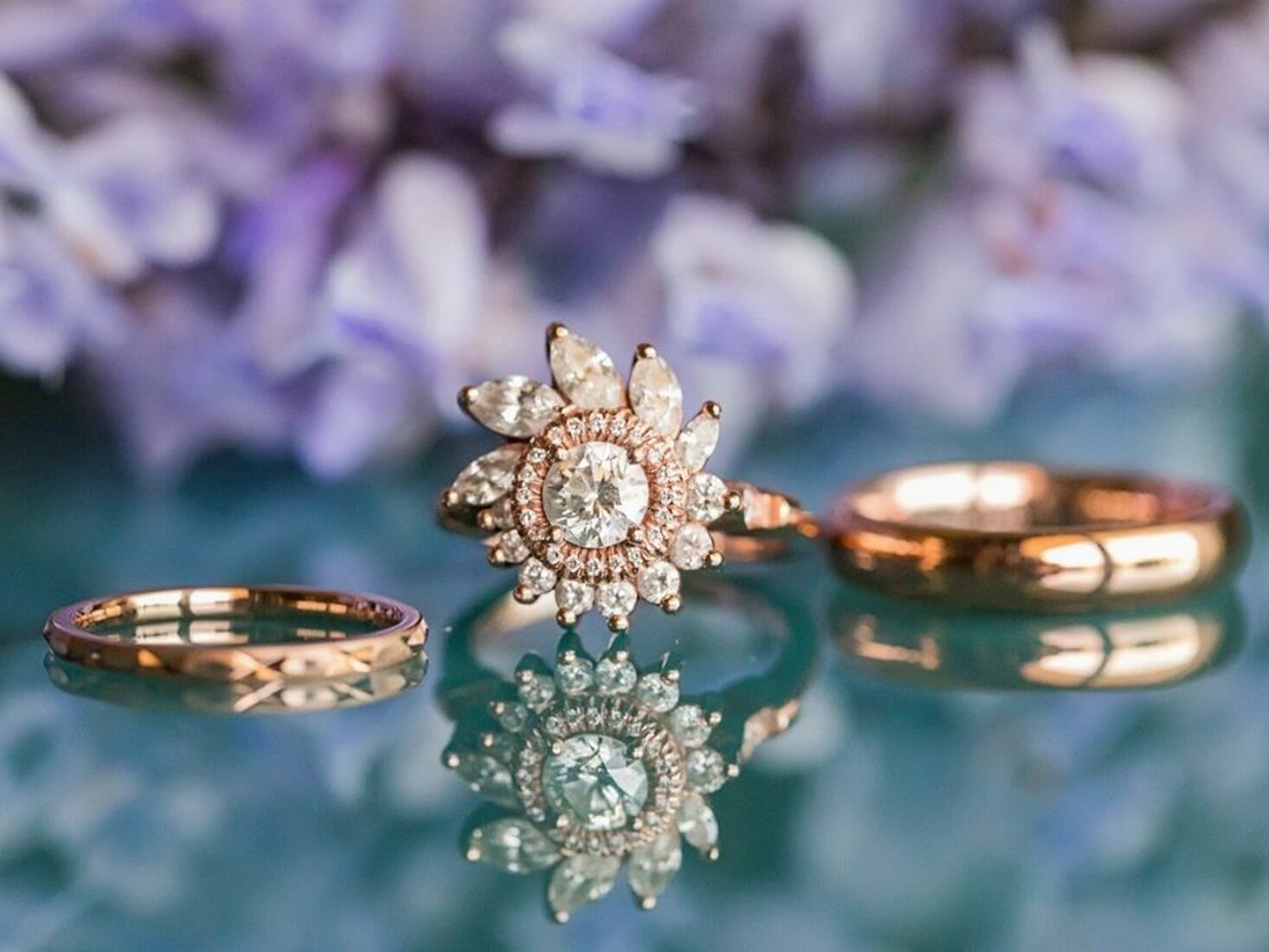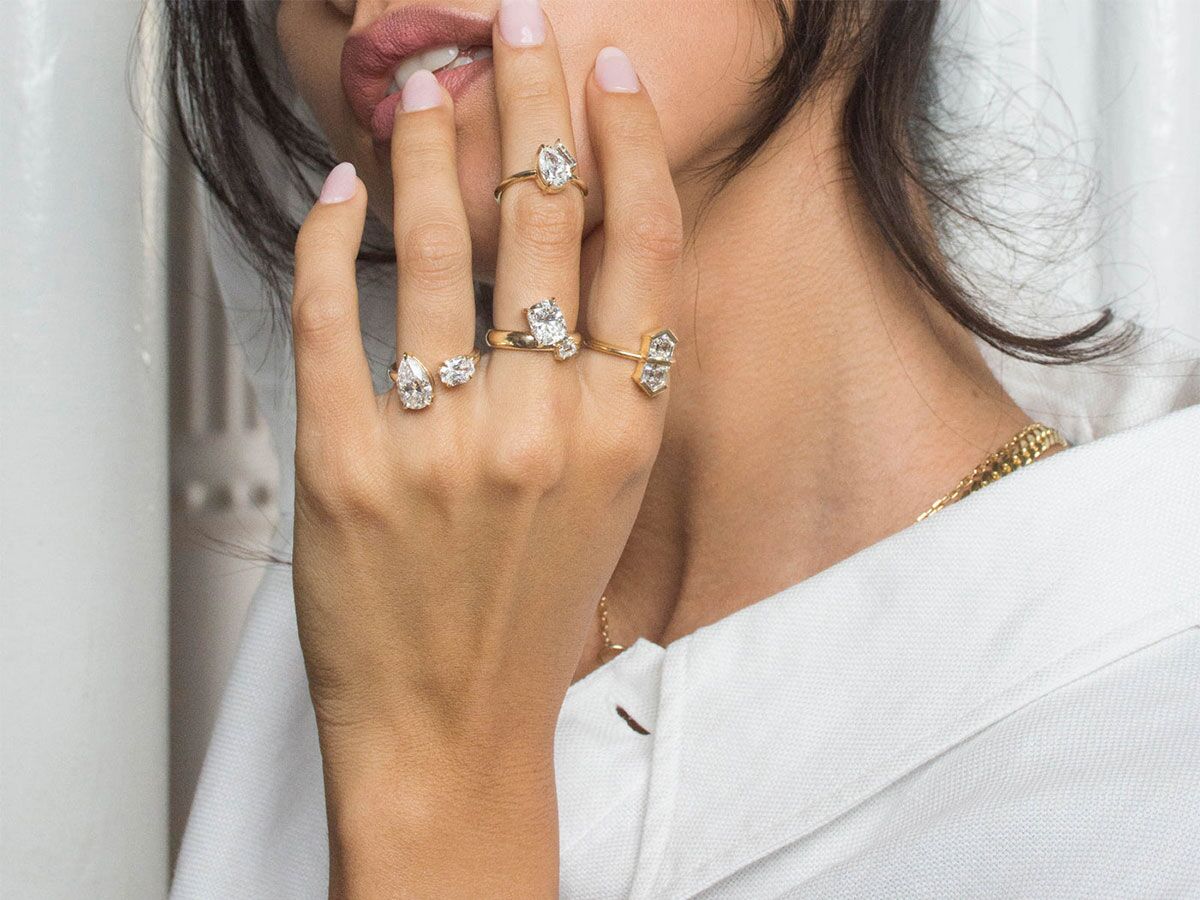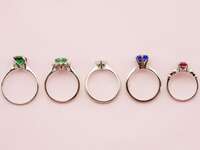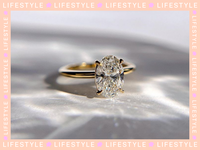Why Are Engagement Rings So Expensive? The Cost, Deconstructed

If you're reading this, you might be ready to take the next step in your relationship by getting engaged. (Congrats, bestie!) As you begin your engagement ring search, you've probably realized that fine jewelry doesn't exactly come with a low price tag. So, why are engagement rings so expensive? It's a valid question, and one that might plague your mind as you dive into the world of diamonds.
According to The Knot's data, the average cost of an engagement ring right now is $5,500—but that includes so much more than just the center stone. An individually crafted ring usually takes anywhere from two to six weeks to be created. (It can sometimes take even longer, depending on the complexity of the design.) Throughout that lengthy process, skilled artisans rely on meticulous labor and craftsmanship to transform some of the most valuable materials in the world. With all these factors coming into play, it's no wonder why engagement jewelry is seen as an investment.
Of course, as important as it is to be highly selective when it comes to finding the perfect ring, it's just as crucial to source a stone that comfortably fits within your budget. (Psst: When it's time to start the rest of your wedding planning journey, use our free budget tool to better understand prices and keep your spending on track.) Below, three industry experts break down the nitty gritty details of why diamonds and engagement rings are so expensive, including all of the elements that factor into the overall cost.
Why Are Engagement Rings So Expensive?
When you walk into your local jeweler's store, you'll be met with plenty of dazzling diamonds on display in luxe, illuminated cases—but a ring's journey to the showroom is a complicated and lengthy one, which directly impacts its price. Here are six of the top factors that contribute to the cost of a gemstone or diamond ring.
Raw Materials
Let's go back to the beginning, shall we? Engagement rings are often made with diamonds or precious gemstones, set in high-quality metal (like platinum or gold). Those materials alone are incredibly valuable, which is why the cost of an engagement ring typically falls in the thousands. Plus, consider the fact that mined diamonds—which are one of the most common center stones—are limited in availability.
"Natural diamonds are heavily regulated, which ensures their quality and authenticity but also contributes to higher costs," explains engagement ring designer Stephanie Gottlieb. "The use of precious metals like gold and platinum also significantly impacts the price of an engagement ring."
Labor and Craftsmanship
The diamond you see in stores is not the same as the rock that comes from the earth (or from a lab). The very first step to creating an engagement ring is to take it from a rough, jagged mass and transform it into what you recognize as a stunning center stone—and it takes an incredibly skilled and experienced gemologist or designer to do so.
"Rough diamonds and gemstones, whether they are natural or lab-grown, must be evaluated, cut, and polished by talented experts," says Lorraine Brantner, Gemologist and Sales Manager at James Allen. Once the engagement ring is selected, it's graded by the Gemological Institute of America (GIA) for quality.
After the ring is polished, the expert will craft the perfect setting for that particular stone. "The engagement ring settings for these gems are then made using a variety of methods such as hand-carved wax models, CAD (Computer Aided Design) and pulled wire," Brantner continues. "Once the setting's casting is ready, the jeweler will carefully set all the stones and then add the finishing touches to the ring. Finishing touches include polishing the metal to a high shine or rhodium plating for white gold." The final product goes through one last inspection before it's placed in the store or delivered to a client.
The Center Stone
Perhaps unsurprisingly, the center stone has one of the biggest impacts on the overall cost of an engagement ring. As explained above, each individual diamond is graded during the cutting process, which helps determine its cost. Consider it this way: a flawless 5-carat emerald-cut diamond will have a much larger price point than a 1-carat oval diamond with minor inclusions. Plus, certain gemstones (like sapphires or rubies) may cost less than flawless white diamonds.
Another element to consider is whether or not the center stone is lab-created or a synthetic lookalike (like moissanite), as that may also lower the cost of a ring. Lisa Ingram, Vice President of Merchandising at KAY Jewelers, says, "Lab-grown diamonds are typically less expensive than natural diamonds because their production process is more efficient and less resource-intensive, leading to lower manufacturing costs. Additionally, the consistent supply from controlled environments reduces rarity and prices."
The 4 Cs
As you begin shopping for an engagement ring, you might come across the "4 Cs." Short for cut, color, clarity and carat, Gottlieb says these factors play a "crucial" role in the overall price of a ring. "The quality of a diamond's cut affects how much it sparkles," she notes. "A poor cut can result in a dull appearance, which lowers the price as it's less desirable." The next C measures the absence of color within the diamond. "The highest color grades (D-F) are the most colorless and rare, commanding a premium price," she continues. "However, certain diamond shapes hide color better than others, so we use this knowledge to recommend the best color and clarity pairings. In many cases, the difference between a high and slightly lower color grade is negligible to the naked eye, which can help you save."
Clarity measures the number of visual inclusions within the stone. Since these imperfections are often invisible to the untrained eye, experts can recommend stones that may appear perfect but have a lower cost because of their minuscule flecks. Last, of course, is carat weight, which measures the diamond's size—but a higher number doesn't necessarily mean it's a bigger stone. "Diamonds of the same weight can have different visual spreads," Gottlieb says. "This means you can sometimes choose a diamond with a slightly smaller carat weight that appears larger, saving you money without sacrificing beauty."
Ultimately, Gottlieb says, "Cheaper doesn't always mean worse." But don't stress about memorizing the definitions before a ring shopping appointment. Jewelers will help you navigate the 4 Cs so you can understand exactly why a ring has a certain price.
Metal Setting
Center stone aside, the metal setting is also a major piece of the cost puzzle. The most common setting materials are platinum, white gold and yellow gold—and each have nuanced qualities that impact its cost. "Certain metal settings, like platinum, cost more than others," Ingram says. "Platinum is rarer than metals like gold and silver, making it more expensive to source. Its density and durability also require more material to create a setting, contributing to higher costs."
There's no "bad" option when it comes to selecting the setting material, but it is important to keep the ring's long-term wear in mind. While you can save a little upfront by opting for a white gold band, you might need to get it professionally repaired for tarnishing over time. On the flip side, investing in a platinum setting may save you a few trips to the jeweler in the future.
Inflation
Just like inflation can affect the cost of wedding goods and services, the same is true of engagement rings too. A rise in demand creates a rise in cost, and some experts predict that the price of diamonds could grow as much as 10% by 2025. In fact, Gottlieb has already seen a similar impact on the cost for engagement ring settings: "Gold prices, for instance, have seen a steady increase, reaching record highs in recent years, including an all-time high in September 2024."
Not to worry, though. It's quite common for prices to fluctuate in the jewelry industry. If anything, this illustrates the importance of sourcing your engagement ring from a trusted jeweler or retailer. While there are many elements that determine why engagement rings are so expensive, nothing can replace the benefits that come with working one-on-one alongside an expert. Industry pros will answer your questions along the way, and they'll help you find the perfect proposal piece within your price range.























